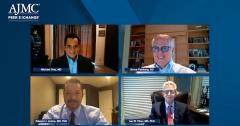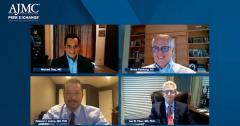
Transplant-Eligibility and CAR T Considerations in R/R NHL
Episodes in this series

Experts in oncology provide insight on determining patient eligibility for transplant and CAR T-cell therapy as well as best-practice approaches for the treatment of R/R NHL.
Transcript
Bruce Feinberg, DO: Mike, you’re in a practice that doesn’t do transplant, in terms of understanding from the perspective having many different sites of care, how that practice is approaching. With a large geographic area, likely different transplant centers that you might refer to, is there a standard within the practice in terms of an age-based cutoff for transplant eligibility? If so, given the emergence of CAR T which has curative intent and transplant which has curative intent, how are those decisions made within the practice, clinical pathways, other kinds of protocols?
Michael Diaz, MD: We don’t have uniform pathways, predominantly because this is not a common event. And each case must be treated uniquely based on the individual and what their overall medical condition is, how many other medical conditions they may or may not have. Do they have complications related from their treatment or their history of lymphoma in the first place? It’s managed on an individual basis. We have long detailed discussions with the patient. Once we see in the unfortunate incidence that they relapse after first-line therapy, we have a long discussion with them. We connect them with a transplant specialist at that time while we are working on a salvage therapy with them.
We’ll start with salvage therapy. We’ll get them plugged into a transplant specialist, so that they can have informed detailed discussions about their next steps in therapy, hopefully they respond or have a response to the salvage therapy. Most of the time, patients are not going to go to a transplant unless they have a response to salvage therapy. Depending on how they respond to their salvage therapy will determine whether or not they would consider moving on to a transplant, autologous, their own stem cell transplant or whether or not they may want to consider something like a CAR T-cell. You must have several discussions at several different points with the patients depending upon how their condition unfolds and how it responds to treatment. Once again, each case is going to be unique depending upon the individual patient.
Bruce Feinberg, DO: Michael, when a doctor in your practice refers a patient to a transplant center are the transplanters also administering CAR T? Will your doctor refer that patient for whatever the transplanter thinks is best or do you refer for transplant versus CAR T or CAR T versus transplant and expect that to be done? Who’s making that choice of what that salvage therapy will be, is it the referring oncologist or is it the transplanter who’s receiving that referral?
Michael Diaz, MD: In an ideal world, it’s the whole team. It’s the referring oncologist, transplanter, and it’s patient. And that’s something that takes a lot of effort to make sure that you do have those lines of communication open at the very beginning which is ideal. But the patient needs to be involved in this process. It’s complicated. None of the options are fantastic or glorious. You’re looking at trying to save their lives, and you have to have different perspectives because other people are going to have other perspectives. And sometimes you make better decisions by looking at things from several different options. We like for it to be a team effort.
Bruce Feinberg, DO: Ian, within your practice environment, is there a formal age cutoff, is it a chronologic age, a physiologic age for transplant eligibility?
Ian W. Flinn, MD, Ph: There’s no longer a chronological age. It used to be 65 or so that we would cut off the eligibility. Now it’s more physiologically how they’re doing, and that’s a hard thing to quantify, but we do end-organ function testing, we check their heart function, their lung function, kidney function. As long as physiologically they can tolerate the high-dose therapy, then we think it’s worth a try in those patients. It’s not uncommon to transplant patients into their mid-70s. If you get above that, most patients don’t tolerate no matter how good a performance status they had.
Bruce Feinberg, DO: Right. You would think just organ reserve would start to be an issue even if the numbers on the chemistries look okay.
Ian W. Flinn, MD, Ph: Exactly.
Bruce Feinberg, DO: Ed, the same? Is there any definitive cutoff on age for transplant?
Edward J. Licitra, MD, PhD: There’s not a definitive cutoff. Physiologic age is appropriate. But to Mike’s point, being a community oncologist taking care of patients, our patients see us as being the true quarterback of their care. As Mike discussed, multidisciplinary or multiple people involved in the decision making with a patient is critically important. Quite often, our patients who we’ve taken care of for months or years when they relapse, they go and see a transplanter who makes a recommendation and then they often come right back to us for a discussion. Ultimately the transplanter does make the decision, but it’s our job as their primary oncologist to make sure that everybody is comfortable with that decision. It’s just to harmonize the decision-making process and make sure that everybody is on the same page. That’s the critical role that we play.
Bruce Feinberg, DO: Ian, do you consider yourself a transplanter? Are you a transplanter who does CAR T? Do you administer CAR T or are you a community oncologist that focuses on hematologic malignancies?
Ian W. Flinn, MD, Ph: All the above. I’m a transplanter, I administer CAR T-cells, and I’m also a community oncologist that specializes in the therapy for patients with lymphoma.
Bruce Feinberg, DO: When that patient is referred to you, and they may be even referred from one of your own colleagues in the practice given the number of sites that TO has, when that happens and that patient is referred, we’ll pick something out, 68-year-old, looks like they had reasonably good performance status and preserved organ function, and they’re one year out newly diagnosed with relapse, and they’re referred for transplant. In that setting, do you approach that as they’ve been referred to transplant so I’m a transplanter right now and wearing that hat or I really believe that CAR T is the better option and I’m going to call that referring physician and discuss that option, that when I meet with the patient, the doctor knows that I’m going to entertain this conversation?
Ian W. Flinn, MD, Ph: Right now we can’t get CAR T-cells for patients unless the FDA approved indication and they are not a candidate for transplant, meaning they had to have a second-line therapy and they don’t respond to it or they fail after an autologous transplant. Generally, that patient, the example you gave, I would have with that patient is we’re proceeding with evaluation for a transplant like your physician told you. But if it doesn’t work, if you don’t respond to the salvage chemotherapy, then we’re going to plan to go directly to CAR T-cells. I explain to the patient exactly what that means and then I call up the doctor beforehand. As we heard earlier, a lot of this is all about communication. Generally, I get a call before I see the patient, so I’ve already had that discussion with the referring doctor about what we’re likely to do or where we’re going.
Bruce Feinberg, DO: The patient gets referred, the same patient, but the doctor says they’re referring for CAR T because they believe at age 69 that they’re not transplant eligible. Does that fall on you if they’re referred for CAR T, to be able to tell them we believe they are transplant eligible and we should proceed with transplant?
Ian W. Flinn, MD, Ph: There aren’t too many people that can’t get CAR T-cells and they can’t be transplanted. It’s more about a sensitivity to the chemotherapy, to a second-line therapy that makes you ineligible for the transplant or eligible than it is that if you have a bad heart, you’re probably not going to be eligible for CAR T-cells as well. If you have bad lungs, I’m not going to want to be able to give you CAR T-cells. It’s not that different of eligibility for a CAR T-cell in terms of physiological function, patients’ pulmonary function. I’ve never been in a situation where occasionally someone thinks they’re referring them for CAR T-cells because they’ve heard me talk about how wonderful CAR T-cells, but they’re in reality not eligible for these reasons we can’t get them for them. Sometimes we have clinical trials, and if I think a person is best served by getting CAR T-cells and the referring doctor agrees, then we try to do that.
Bruce Feinberg, DO: Great. Ed, we’re in a situation now, we’re starting to understand that there is this relapsed/refractory settingwhere CAR T eligibility currently exists even though we have a potentially curative treatment, even though there has been a tremendous amount of excitement in the general medical oncology arena over this new line of therapy which again gets back to the process of referral and what that oncologist, the community is going to say about what they’re referring for. It’s a referral, I’m going to refer you to a specialist and they’ll make that decision because let’s say your age is 72 where we need to examine your heart, and your lungs, and your kidneys to see what’s best for you. It makes it more difficult than just having one referral concept of you’re going to see this doctor to get X.
Edward J. Licitra, MD, PhD: When I make the referral, unless there is a very clear path forward that I’m passionate about, my practice is to leave the door open. Let that patient have a discussion with the referring doctor, the doctor we referred to. Ultimately, based upon that recommendation, come back and synthesize it all and then come down one way or the other. I personally, at least my style is not, in many situations, to say definitively this or that. I would owe the courtesy to the person I was referring the patient to understand because they’re usually people that we’ve worked with before, and there’s a communication and trust there. But once they come back, we have a broad discussion regarding the options that were presented and the path that we think is best for that patient.
Bruce Feinberg, DO: Excellent.
Newsletter
Stay ahead of policy, cost, and value—subscribe to AJMC for expert insights at the intersection of clinical care and health economics.




































